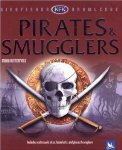Through the Looking Glass Children's Book Reviews
Kingfisher Knowledge: Pirates & Smugglers
Nonfiction
For ages 9 to 12
Kingfisher, 2005 ISBN: 0753458640
For thousands of years, humans have travelled on the world’s ocean and seas, transporting people and goods from one country to another. For thousands of years pirates have attacked the ships and the ports that they have used. Sometimes pirates were after the valuable goods on the ships they attacked, and sometimes they were keen to capture and sell the ships’ passengers. When he was a young man, Julius Caesar was captured by Cilician pirates. Luckily for him, Julius was wealthy and his ransom was paid. Other people were not so lucky, and many fell victim to the corsairs who sailed up and down the Mediterranean. It is believed that up to one million Europeans were sold as slaves during the fourteen and fifteen hundreds.
Though pirates lived outside the law, privateers were actually hired by one power to attack the ships of another. The captains of privateer ships were given a license to attack ships belonging to an enemy state. These licenses were called letters of marque, and men such as Francis Drake and Sir John Hawkins carried them in the name of their monarch, Queen Elizabeth I of England.
During the “Golden Age” of piracy, some pirate captains were able to steal a veritable fortune in their lifetimes. A life of piracy attracted all kinds of people, many of whom were escaping slavery or seeking a life that was far more democratic than life on land was. Though piracy could be lucrative, it was also very dangerous and many pirates died young. Many got sick, others were mortally injured during battles, and not a few were executed by the authorities when they were caught.
Smuggling was also a dangerous way to make a living. It too could be highly lucrative, but there was always the threat that one would be caught by revenue men or soldiers, and the penalty for smuggling was death or transportation to a penal colony.
In this excellent nonfiction title, three chapters explore piracy and smuggling from their beginnings many centuries ago to the present day. At the end of each chapter, a summary goes over the main topics that were discussed in that chapter, and there is a section where sources of further information are listed. There include book titles and website addresses.
In addition to the informative and interesting text, every double page spread contains annotated illustrations and photos, and there are also maps to look at on several pages.
This book is one of the titles in the large Kingfisher Knowledge library.




